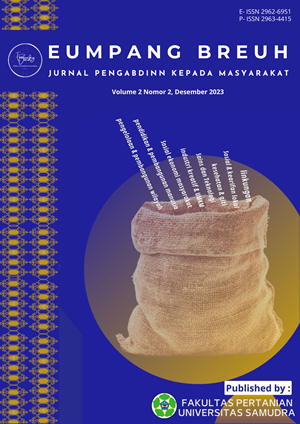Gemarikan and Fishery Product Diversification Training as Effort of Reduce Stunting Prevalence
Kampanye Gemarikan dan Pelatihan Diversifikasi Produk Perikanan Sebagai Upaya Pencegahan Stunting di Desa Babul Makmur Kecamatan Simeulue Barat Kabupaten Simeulue
Abstract
Stunting is a condition of failure to thrive in two-year-old babies due to chronic malnutrition. A short height characterizes babies experiencing stunting compared to other babies their age. One of the districts in Aceh Province with high stunting cases is Simuelue, with a prevalence reaching 35.7% in 2017. Various factors influence stunting, including nutrition and food quality. This service activity aims to increase public knowledge about the diversification of processed fish products and increase interest in eating fish, contributing to reducing stunting. The activity was carried out in two stages. The first is a campaign to enjoy eating fish using the socialization method. The campaign begins with socializing material about the benefits of eating fish, and introducing the types of fish. This activity ended with distributing processed fish meat products, namely nuggets. The second stage is the diversification of processing products using the workshop method. The workshop begins with explaining the steps for making a product, and then participants are divided into groups and make the product with their group. At each stage of the activity, a pre-test and post-test are given. The post-test results showed that understanding of product diversification and popularity increased after this activity.
References
Kris-Etherton, P. M., Harris, W. S., & Appel, L. J. (2002). Fish consumption, fish oil, omega-3 fatty acids, and cardiovascular disease. Circulation, 106(21), 2747-2757.
Talaei, M., Dianatkhah, M., Mohammadi, M., Yaghoobi, N., & Shahabi, P. (2017). The effect of fish oil supplements on blood pressure. ARYA Atherosclerosis, 13(2), 68-74.
Micha, R., Wallace, S. K., & Mozaffarian, D. (2010). Red and processed meat consumption and risk of incident coronary heart disease, stroke, and diabetes: a systematic review and meta-analysis. Circulation, 121(21), 2271-2283.
SanGiovanni, J. P., & Chew, E. Y. (2005). The role of omega-3 long-chain polyunsaturated fatty acids in health and disease of the retina. Progress in Retinal and Eye Research, 24(1), 87-138.
Zheng, J. S., Huang, T., Yang, J., Fu, Y. Q., & Li, D. (2012). Effects of green tea, black tea, and coffee consumption on the risk of esophageal cancer: a systematic review and meta-analysis of observational studies. Nutrition and Cancer, 64(6), 864-872.
Swanson, D., Block, R., & Mousa, S. A. (2012). Omega-3 fatty acids EPA and DHA: health benefits throughout life. Advances in Nutrition, 3(1), 1-7.
Boelsma, E., Hendriks, H. F., & Roza, L. (2001). Nutritional skin care: health effects of micronutrients and fatty acids. The American Journal of Clinical Nutrition, 73(5), 853-864.
Grosso, G., Pajak, A., Marventano, S., Castellano, S., Galvano, F., Bucolo, C., ... & Caraci, F. (2014). Role of omega-3 fatty acids in the treatment of depressive disorders: a comprehensive meta-analysis of randomized clinical trials. PloS One, 9(5), e96905.
Beal, T., Tumilowicz, A., Sutrisna, A., Izwardy, D., & Neufeld, L.M. 2017. A review of child stunting determinants in Indonesia. Matern Child Nutr. 2018(14): 1-10.
World Health Organization [WHO]. 2015. Stunting in A Nutshell. https://www.who.int/news/item/19-11-2015-stunting-in-a-nutshell (diakses 3 Agustus 2023).
Kemenkes. (2018). Buletin Stunting. Jakarta: Kementerian Kesehatan Republik Indonesia. 301(5), 1163–1178



